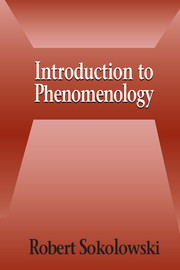Book contents
- Frontmatter
- Contents
- Acknowledgments
- Introduction
- 1 What Is Intentionality, and Why Is It Important?
- 2 Perception of a Cube as a Paradigm of Conscious Experience
- 3 Three Formal Structures in Phenomenology
- 4 An Initial Statement of What Phenomenology Is
- 5 Perception, Memory, and Imagination
- 6 Words, Pictures, and Symbols
- 7 Categorial Intentions and Objects
- 8 Phenomenology of the Self
- 9 Temporality
- 10 The Life World and Intersubjectivity
- 11 Reason, Truth, and Evidence
- 12 Eidetic Intuition
- 13 Phenomenology Defined
- 14 Phenomenology in the Present Historical Context
- Appendix: Phenomenology in the Last One Hundred Years
- Select Bibliography
- Index
3 - Three Formal Structures in Phenomenology
Published online by Cambridge University Press: 05 June 2012
- Frontmatter
- Contents
- Acknowledgments
- Introduction
- 1 What Is Intentionality, and Why Is It Important?
- 2 Perception of a Cube as a Paradigm of Conscious Experience
- 3 Three Formal Structures in Phenomenology
- 4 An Initial Statement of What Phenomenology Is
- 5 Perception, Memory, and Imagination
- 6 Words, Pictures, and Symbols
- 7 Categorial Intentions and Objects
- 8 Phenomenology of the Self
- 9 Temporality
- 10 The Life World and Intersubjectivity
- 11 Reason, Truth, and Evidence
- 12 Eidetic Intuition
- 13 Phenomenology Defined
- 14 Phenomenology in the Present Historical Context
- Appendix: Phenomenology in the Last One Hundred Years
- Select Bibliography
- Index
Summary
There are three structural forms that appear constantly in the analyses done in phenomenology. If we are aware of these forms, it will be easier to understand what is going on in a particular passage or the development of a particular theme. The three forms are (a) the structure of parts and wholes, (b) the structure of identity in a manifold, and (c) the structure of presence and absence. The three are interrelated, but they cannot be reduced to one another. The first two of these structures are themes that have been developed by many earlier philosophers; Aristotle has much to say about parts and wholes in the Metaphysics, for example, and Plato and the Neoplatonic thinkers, as well as the scholastics, explore the idea of the identity within differences, the one in many.
However, the theme of presence and absence has not been worked out, in an explicit and systematic way, by earlier philosophers. This issue is original in Husserl and in phenomenology. Presences and absences can be blended in remarkable ways, and the exploration of such blends can serve as a valuable theme in philosophy. I believe that phenomenology worked out this new philosophical dimension precisely because it was trying to counteract the epistemological problems of modern thought, the egocentric predicament initiated by Descartes. Phenomenology made a positive advance by responding to a philosophical confusion, much as Plato worked out his understanding of unity and form in response to the challenge of Sophistic skepticism.
- Type
- Chapter
- Information
- Introduction to Phenomenology , pp. 22 - 41Publisher: Cambridge University PressPrint publication year: 1999



